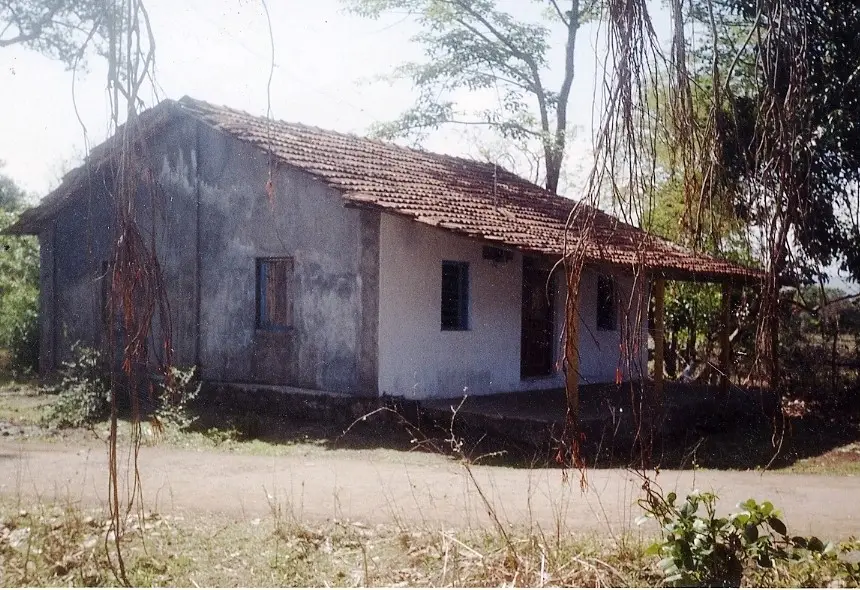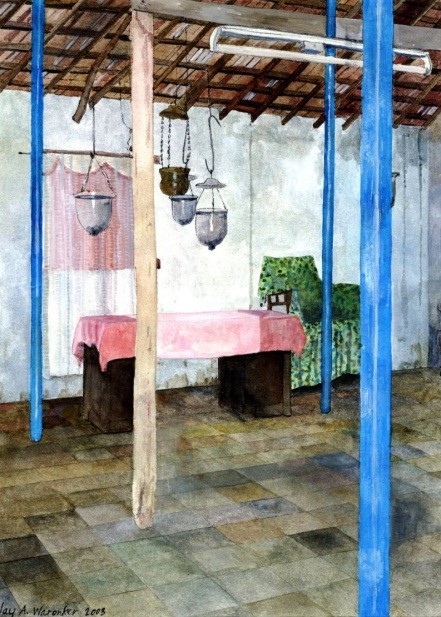Maharashtra - Ambepur Synagogue
Early 20th century
Ambepur Raigad District, Konkan Region Maharashtra, INDIA
This Raigad District/Konkan Region synagogue is today closed and locked. Guests need to arrange a visit to the building in advance via the Mumbai Bene Israel community. There is no telephone number or email for this building site. Contact this website for possible assistance. To reach this former synagogue and the nine others throughout the sprawling and picturesque Konkan Region, it is best to hire a car and driver from Mumbai for two full days. There is a convenient ferry that takes passengers from Mumbai’s Gate of India to Alibag in the Konkan Region. Here travelers would have to arrange for private transportation to this and other regional synagogues, which will be challenging since finding someone near the ferry jetty who knows where they are all located is difficult. The alternative is to begin in Mumbai via informed car and driver, and travel all by roads. This is the longer option but will insure that all the synagogues can be reached. For the overnight stay, the comfortable Radisson Hotel on Alibag-Pen Road, Gondhalpada, Varasoli, Alibag, Raigad is suggested.

According to narratives, the Bene Israel Jews were ancient traders from the Middle East who for many years conducted business in India. Eventually they came to settle – perhaps more than two millennia ago – on a permanent basis primarily in a collection of small towns and villages in the Raigad District of the Konkan Region of coastal Maharashtra. They continued to live there for centuries as a mostly isolated disaporic Jewish enclave, following various Jewish customs and lifestyle practices amongst larger native Indian communities. Centuries later, beginning in late 1700s but especially by the mid-1800s, many of the Bene Israel relocated to Mumbai as well as Ahmedabad, Pune, and Karachi Pakistan when these colonial cities were expanding and offering job and lifestyle opportunities. Yet not all Bene Israel Jews chose to leave the Konkan Region. For those that remained, the synagogues that had already been built or the ones realized later continued to remain active religious and communal centers for many more decades.
Beginning in the mid-twentieth century, as a result of political and social change in India, the Bene Israel began to leave India mostly for Israel. At that point, the entire Bene Israel community numbered according to estimates some twenty thousand people. From this pattern of immigration, the Bene Israel population of Bene Israel dropped precipitously to a few thousand, and the number of Jews currently living Konkan Region is quite small. Of the thirteen synagogue buildings built in the assortment of towns and villages in this region from the mid-nineteenth to early twentieth centuries, only eleven physically survive today. Of those, only a few are active houses of prayers, others endure marginally, and the balance has closed and sit empty or converted to others functions.

The synagogue in the village of Ambepur represents another of the thirteen Bene Israel congregations that were organized in the Raigad District from the mid-nineteenth to early twentieth century. Today, ten buildings survive. In time, these small congregations erected proper synagogues, and in cases some of these buildings were rebuilt for various reasons into the first quarter of the twentieth century. The synagogue at Ambepur was organized in the late nineteenth century. Constructed by means of contributions by its membership, the modest one-room, single-story building – one of the smallest and simplest of Indian synagogues – sits on a mostly unspoiled site surrounded by open land and mature trees.
Ambepur synagogue is a rectangular structure composed of structural brick veneered in white chunam (polished lime). Atop the walls is a gable roof finished in flat clay tiles. This roof, with its deep overhangs in response to the monsoon climate, covers over a porch, which runs along the long (east) end of the building. Simple square painted wooden columns run along the front of the porch to support the roof. Wooden shuttered windows and a pair of wooden doors providing access, natural light, and ventilation into the sanctuary are placed along the synagogue’s porch elevation. Similar windows can be found along the two short (north and south) sides of the structure.
The rectangular sanctuary features a natural stone tiled floor, off-white chunam walls, painted wood thin structural columns, and an open ceiling where the wooden joists and underside of the clay roof tiles are exposed. Hanging from the ceiling are various lighting fixtures, including glass dome, metal, and modern fluorescent tube ones. The space follows the planning of other Bene Israel synagogues with its centrally-positioned tebah (bimah, or an area containing a reader’s platform from where the service is led) and to the far wall the heckal (ark). The tebah, a wooden reading table, is constructed out of wood that has been painted. Placed in the center of the western elevation that is closest to Jerusalem as per synagogue convention, the heckal is a wooden cabinet with its doors set in the wall that is draped in the traditional cloth called the parachot. Flanking the heckal are two special chairs, both covered in cloths. One is dedicated to Elijah, and the other to the brit mila, or circumcision ceremony.
Today this synagogue is closed since there are too few Jews residing in the immediate area. During the second half of the twentieth century, the local Jews immigrated mostly to Israel. For years a Jewish man, native to the area, served as guardian of the synagogue, proud of the building and his family’s local Jewish heritage.
